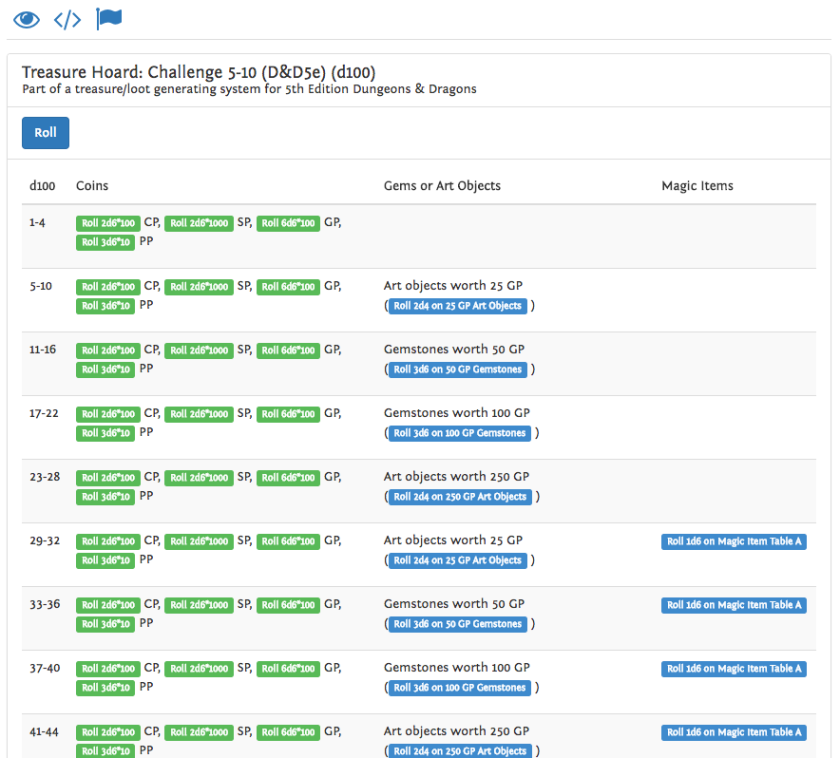Chartopia (the massive RPG random table library and editor) seemed like my best chance to date to make a piece of software that earns more than a token amount of pocket money.
How wrong was I.
Optimistically this project may just be a ‘slow burner’ so for the time being I’ll chip away at features. I thought the pain points we were trying to solve where perfectly valid though.
What is Chartopia trying to solve
So many books!
I thought one of the best selling points was that Dungeon/Game Masters would be the ability to leave all the books at home. Have you seen some of those game books? They’re huge. Try bringing those to a house party.
Just like Serato solved a massive pain point in the DJ scene by allowing DJs to leave their crates of music at home, I hoped Chartopia’s ability to have all of a DM’s charts in an easily searchable and manageable library would be a tempting prospect.
Streamlining play
Roleplaying games certainly aren’t the fastest moving activity out there so anything to help avoid flicking through books and doing complicated dice rolling across tables is sure a good thing.
Next to being a resource, Chartopia is a random table editor. Some tables get quite complicated when rolling on one table requires getting a result from some other table or tables (a name generator comprising of first and last names is an example). It gets even more complicated when you want equations e.g. d12 gold pieces or perhaps d4 items from a ‘table of random items’. There can be a lot of dice rolls and table lookups.
Roll just once.
The great thing about having a finished chart (or charts that link to other charts) is that with one button press, Chartopia collates all the results together and present the resulting text and numbers to the user.
Content management
Books have tactile appeal whereby one can flick through the pages, mark them, use the index. Digital can never replicate the feel of books (ebooks are only better if you’re always on the move and need the space). That means Chartopia has to better the books in some other ways.
Ctrl-F
Yes, search. If search is better than an old-school book index lookups or flicking through the pages, then we have a winner. Searching through all charts ever created probably isn’t desirable, so Chartopia also has a folder structure. It’s one-to-many meaning a single chart could be added to many folders so it’s not like a traditional Windows/Mac file system (short of using symbolic links). This allows the DM to somewhat prepare a game or just organise their charts in an alternative way to just keyword-tagging them.
Content – The impediment (yet key) to success
Herein lies the biggest hurdle to Chartopia being useful; content.
Pinterest is useless without content but who makes the content? The users do. But if there’s no content, why should users be there in the first place? The content is the first thing you see when you go to Twitter, Pinterest, DeviantArt. You don’t see an editor to make your own content, you see the preexisting content of others.
Unfortunately making content for Chartopia isn’t as trivial as ‘pinning’ a few images so in order to demonstrate what useful content looks like, I had to trawl the internet looking for random tables shared on blogs and .pdf files. Thankfully there are users contributing a few charts now but unfortunately the bulk of content I had to manually (via copy-paste and lots of regular expressions and implementing a .csv importer) add to the site. The best I could do given the material was sourced elsewhere, was put in a citation field.
It’s a slow process but it also helped be better understand some of the pain points of the editor. Thankfully the front page is now full of chart content for users to browse.
Potential Customers
Scott assured me there were many, many DMs out there that would find Chartopia immensely useful. It’s feeling more and more like this may not be the case.
I suppose technically Chartopia is SaaS (software as a service) but I’m yet to figure out a way to monetise Chartopia. This is not good considering that servers aren’t cheap and this is costing me a reasonably amount of money despite the incredibly modest amount of traffic.
Maybe we just need to advertise
Yeah… I may have to bite the bullet and try some of those shady-looking advertising sites. Perhaps getting some targeted ads on role playing sites may help us.
At most all we can do at the moment is post articles, share via word of mouth and get some blog time on other sites. Scott has been writing articles about Chatopia at Nerdarchy.
Still in ‘beta’
There’s the cliche that if your software has no bugs, then you’ve released too late. Well, I can tell you that Chartopia is very much released and very much has bugs. There are so many useful features that need to implemented though, that I feel that Chartopia is in perpetual beta. I suppose if gmail can be in beta for over 5 years, Chartopia can do it too.
Turning a profit
Chartopia has been (and still is) a great hobby project (albeit a very long, more than 2 years to date hobby) and I’ve learnt a lot but gosh, it would be useful if this thing could pay for itself.
Unlike Pinterest, which currently has no monetisation and therefore makes no money, I want to actually make a useful service that people are willing to pay for. I may just have to sell-out and try Indiegogo or something.
When roleplayers want new material, I want Chartopia to be the first place they refer to. It’s starting to look like a lofty goal.

